Bill Frisell is the ideal musician of the postmodern age – the age of “complexity.” So ideal, in fact, that he remains unique.
It is no surprise that jazz has been central to his work since the start of his career. In a sense, that focus emerged by exclusion – much as it did for John Zorn, another emblematic figure of the era with whom Frisell collaborated prominently in the late 1980s and early 1990s (and occasionally thereafter). Yet Zorn and Frisell are artists of very different, even opposing, principles. Zorn’s music offers an implicit critique of the contemporary raison d’être of musical language: a “zapping” method that edits together inserts from disparate genres, performed anew or sampled, to create metamusical works out of music’s own hot medium. Frisell, by contrast, composes music that fuses “high” and “low” idioms and often seeks sonic primacy within a creationist language keenly attuned to music’s autonomous properties – a language distinct from what music may share with other arts and unwilling to sacrifice that autonomy to aesthetic or synaesthetic speculation.
Born in Baltimore in 1951 and raised in Denver, Colorado – where jazz was hardly in the air – Frisell took up guitar as a teenager after studying clarinet without conviction, drawn to the pop of the 1960s. Jazz entered his life at seventeen, when he fell in love with a Wes Montgomery record. The music he would go on to make interweaves jazz, blues, country, rock and pop, with a steel-guitar sensibility as connective tissue. For that reason, his official career likely began a little “late”, and the fact that jazz propelled it may have been a coincidence – a fruitful one. In 1977 he studied with Jim Hall and refined his composition and arranging at Berklee in Boston, studying with Michael Gibbs and Gary Burton and befriending Pat Metheny. Those relationships brought him into view.
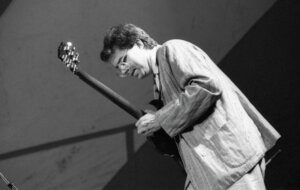
Early in 1979 he made his studio debut on Eberhard Weber’s ECM album Fluid Rustle, which gave him modest visibility. In 1980 producer Hal Willner heard him and invited him onto Amarcord Nino Rota, the tribute to Nino Rota’s Fellini scores – even entrusting Frisell with a solo performance from Giulietta degli spiriti. In the summer of 1981 he joined Paul Motian’s quintet and, that December, recorded the controversial ECM album Psalm. Thanks in part to Frisell’s pervasive contribution, it was a daring, heterodox work. Willner and Motian prized above all his unique, dreamlike imagination. That dreamlike quality inevitably commands the short Giulietta degli spiriti medley – Frisell’s first performance and arrangement as a bandleader – yet there he appears more the sensitive interpreter than a proactive shaper. Leading on acoustic guitar, his highly evocative lines – still unable to articulate what would later bloom in his electric-guitar and synth language – flow over a colourful bed of synthetic sound, producing a classic concertante form.
By contrast, on Motian’s “Psalm” there is no doubt that Frisell’s oneiric vocation is transmuted into his own unique forms – forms that ally themselves to Motian’s multiple oneiric logics and complete them. Already he stands out, as an instrumentalist, as a fully authorship-bearing presence, because this quintessentially jazz characteristic belongs to him through a set of traits that partly diverge from the jazz language. Above all, he is a guitarist of sound rather than phrasing or “touch”. His palette stretches from the most acoustic to the most synthetic, from veiled to abrasive, often modulating volume within a single performance. Notes slide into one another with legato or small glissandi that mask the initial attack. His improvisations tend either toward pure colour or toward melodic lines that shadow the theme more or less closely. The acrobatic invention so dear to jazz is not native to his artistic nature or culture, which is postmodern – even in its emancipation from Dionysianism.
Within Psalm, the apex of his alchemy is “Étude”, performed solo: a concentrated meditation on the piece’s recurring harmonic cell – a small masterpiece. Yet the truly new phenomenon is the effect of his work in performances shaped by a quasi-symphonic use of the ensemble. With long tones he administers colours that traverse and envelop the harmonic-melodic unity of a theme, braiding into saxophone solos by Joe Lovano or Billy Drewes and subtly altering the sound. Brief solo asides rise delicately from the texture only to return and fade. These diffuse, almost omnipresent interventions “complete” the genetic information of each Motian piece, whether its soul is dreamlike, liturgical, folkloric, rock-hardened, or some intriguing combination.
After Psalm, many bandleaders – especially within ECM – sought him out, often blending his sound with Eberhard Weber’s amplified double bass. Hear Weber’s Later That Evening (1982) and Jan Garbarek’s Paths, Prints (1982) and Wayfarer (1984), the latter among the saxophonist’s finest. Meanwhile Frisell recorded as a leader for ECM in 1982, though for much of the decade his principal showcase and laboratory remained Motian’s groups – above all the legendary Motian–Frisell–Lovano trio, active since 1984. In that trio Motian functioned within a system of instrumental actions that were very different yet equal. Debuting on ECM with It Should’ve Happened a Long Time Ago, the trio initially presented an expanded, high-definition version of Psalm’s core. Frisell’s solo voice is sketched in the short suite “Introduction”, from which he distils bare melodies. He counters that striking episode with scorching, organ-like synths on “Fiasco.” Yet his primary contribution lies in the way his oneiric vocation – a hunter of memories and associations – overlays the differently rooted dream logic of Motian’s writing. In “Psalm” he grafts particular colours into the overall sonority – at times producing an effect akin to a continuous sitar bass – and his exquisite, fleeting solos always remain tethered to the theme.
Frisell’s “natural relation” to a theme during solos evolves differently on the quintet and trio albums outside the ECM orbit, because it intervenes in spaces conventionally reserved for jazz solos, quietly replacing both the function and meaning of those solos. In the trio his lines often stand in contrast to Lovano’s variations and digressions, introducing a function that virtually prolongs the written material – ad-libitum in execution – in a way not unlike Monk’s role as soloist in his own bands. Monk’s solos are solo-themes, not simply thematic glosses. Perhaps not coincidentally, in 1986 Motian began including Monk in his repertoire – balancing emotional impetus with a rational, historical dialogue with jazz’s “tradition of the new.” Frisell inherited a cult for Monk that has never faded.
As a leader on In Line (1982), Frisell did not alter his instrumental expression or his relationship to the composed theme; as a composer he roamed across eras and idioms as freely as Motian. The roots of his musical imagination are different, channelling streams of memory primarily from an America largely ignorant of jazz. His expression is different, too, inevitably more connected to the resources of the instrument. Another “natural relation” Frisell forges is between note and sound – the technical-expressive means by which he transposes his territorial references into the psychic, dreamlike, surreal narrative that has marked his music from the outset.
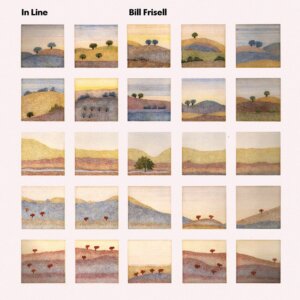
In this sense In Line integrates fully into the ECM aesthetic without replicating its precedents. Recorded partly solo and partly with Arild Andersen on double bass, it presents a uniquely introspective Frisell – with or without Andersen, with or without overdubs, leaning now acoustic, now synthetic. Here he brings all his abilities to bear in linking instrumentation and composition, establishing a poetic statement neither partial nor provisional. Most pieces develop dreamy, allusive themes of American pop, transfigured in symbiosis with their major-key resonances – complex in their intense poetry. It is unfortunate that only three pieces (“Start”, “Throughout”, “Godson Song”) remained in his repertoire. Two pieces without theme – static reflections of repetition – foreshadow future directions, especially in his music for film. An ambiguous presence is the synth-rich sound piece whose stasis seems to speak mainly to similar works by others, interrupting a sequence of images that might otherwise have granted the album the unity of a single work. Whether that was Frisell’s choice or Manfred Eicher’s, we do not know.
Rambler (ECM, 1984) has a wholly different character without contradicting the earlier statement. Frisell’s poetic world is complex and multifaceted, nourished by affection and stimulated by curiosity and openness. The seven originals are as imaginative as before, animated by echoes of a more folkloric America – or an America with a touch of Europe in its memory. The forms are realised by an electro-acoustic ensemble with two brass: Kenny Wheeler (trumpet, flugelhorn), Bob Stewart (tuba), Jerome Harris (electric bass), and Motian (drums), who replaced the expected Al Foster. Except for Motian, Eicher assembled the group from an instrumentation map Frisell conceived for these “experimental” pieces. In many tracks the tuba’s rhythmic action evokes a band. “Tone” opens with a bizarre, modal military fanfare that dissolves into Coleman-esque song. “Music I Heard” is a surreal rhythmic evocation of a band. “Resistor” couples a band-like groove to an ironic, semitone-step riff that refuses resolution. “Wizard of Odds”, a tortuous, harmonically elusive theme reminiscent of Motian, conjures fragments of band music – a vague European reminiscence in 3/4, perhaps a touch of circus. Meanwhile a lyrical, nostalgic major-key vein surfaces in “Rambler” and “When We Go” – manifestos of postmodern daring that leave an authorial stamp on captivating music with just a few ripples. Pop tenderness and country charm dominate – an important strand of Frisell’s poetics. “Strange Meeting” could be its variation and corollary: a minor-key harmonic theme of prolonged tones on a symmetrical 32-bar structure, lightly altered every four bars. Melancholy by nature, it feels like the desolation of deep America – a perfect road-movie leitmotif. Already, in this first version, it is an absolute masterpiece, perhaps the only track on the album that truly exploits Wheeler, with synth colours justified by the music’s mood.
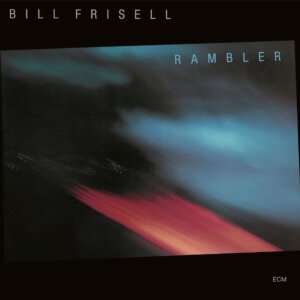
In 1985 Frisell composed the remarkable “Waiting Inside” for Billy Hart’s Oshumare (Gramavision) – a plaintive melody with a shade of Ornette’s expressionism. Yet what most attracted him in that period was radical experiment. In several 1980s collaborations he became a co-leader directly creating deconstructed music.
On Theoretically (1984), a duo with Tim Berne, the saxophonist’s aleatory improvisation predominates; of Frisell’s two pieces, only “Carolina” breaks the rule – a slow, fully composed harmonic melody with a synth sonority that enfolds Berne’s alto. In Smash & Scatteration (1984), a duo with rock guitarist Vernon Reid, Frisell and partner find common ground – no surprise. Of the nine pieces, Frisell wrote five, distributing different modes and levels of experiment: a purely improvised free-rock divertissement (“Fr, Fr, Frisell”); two emotionally narrative uses of synth woven into intelligible fabrics (“Small Hands”, “Black Light”); and two examples of “postmodern difference” in folk-based music (“Size 10 and a Half Sneaks”, “Amarillo, Barbados”). These tracks stand apart from Reid’s not by cultural collision but because they trace to Frisell’s own language.
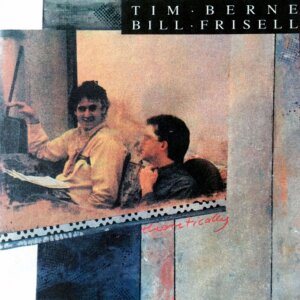
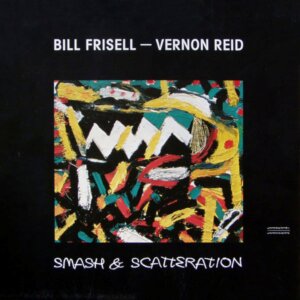
This attitude is confirmed in the Power Tools trio with Melvin Gibbs (electric bass) and Ronald Shannon Jackson (drums) on Strange Meeting (January 1987). Frisell revisits his great piece, returns to “When We Go”, and relocates congested improvisation in “Unscientific Americans”, a more structured free-rock essay than “Fr, Fr, Frisell”, sharing space for both free rock and intelligent pop. Unclassifiable, this music reads as “rock” mainly by sonic connotation. One can hear in it the raw material of the masterly Lookout for Hope (Frisell’s third leader date). In parallel, however, his collaboration with John Zorn (1985–early 1990s) testifies to his appetite for adventure and his enthusiasm for a friend’s. There the connection to instrument and authorship is of a different order: in Zorn’s zapping music, Frisell is like a film actor chosen for his “face” and directed toward a deliberately alienated performance, perfectly compatible with his abilities yet neutral to his personality. What remains of Frisell amid the extremes of those live and studio productions? Very little – even on Spillane, where he was co-arranger. In the Zorn–Frisell–George Lewis trio, delightful glints of Frisell do emerge as they revisit hard-bop gems at the 1987 Willisau Festival (News from Lulu/More News from Lulu, hatART) – paradoxically, in one of Zorn’s rare jazz homages.

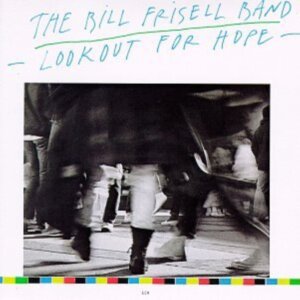
As a leader, by contrast, Lookout for Hope (1987) welds together core motifs of Frisell’s poetics that will remain cornerstones. His final ECM album and the first with his own handpicked quartet – Hank Roberts (cello), Kermit Driscoll (electric bass), Joey Baron (drums) – it was designed less for contrast than for symphonic projection of guitar sonorities. The synth-guitar is gone; there are no horns. Frisell plays mostly electric with a few effects (pedal and hand distortion), occasionally acoustic guitar and banjo. Across ten tracks nearly all his compositional motifs appear, often combined and fused by new nuances that mediate their frictions. Electric and acoustic, “high” and “low”, functional music and minimalist atmosphere, emotional enchantment and oblique dreaminess – no contradiction is allowed to harden. For the first time his music presents itself as a homogeneous whole by virtue of its very heterogeneity. The album is not yet a concept record, but Frisell clearly orders its emotional stages for narrative advantage.
The title track opens with a new road-movie desolation – a sparse melody diffused by the raw, distant blend of electric guitar and cello – less immediately alluring than “Strange Meeting”, yet it establishes the album’s cinematic axis. “Little Brother Bobby” – perhaps the richest country-pop fusion here – offers a major-key, enchanting refrain with a 3/4 bridge in minor that hints at circus sadness; the cello’s contribution is especially telling. Two absolute masterpieces, back-to-back. Thereafter the narrative alternates situations: “Lonesome”, a gentle major-key country-pop miniature on acoustic guitar, floats among still, reflective tableaux; a repetitive, themeless banjo interlude and a pair of more articulated pieces, “Remedios the Beauty” and “Melody for Jack”, draw atmosphere from highly sensitive thematic inserts. Monk’s “Hackensack”, light and danceable – far tamer than 1954 – is treated with affectionate humour, interrupting the flow like a quick flashback: the amused surfacing of a childhood memory. Before a hemi-symmetrical finale, we encounter psychic disorientation – atonality in “Little Bigger” (with an extended cello intro) and blind agitation in “The Animal Race” (recalling Motian’s “Fiasco”). The closing “Alien Prints” revisits “Start” (from In Line), re-imagining its major-key introspection as high-imagination through quartet sound and rhythmic energy. If the album is a road movie, the protagonist is filmed from behind, walking a country road, pausing now and then before fading into the horizon.
Lookout for Hope anticipates the balance between poetry and experiment that would define Frisell a few years later. Still in partnership with Zorn, and now on Elektra (an offshoot of Warner Bros.) after parting with Eicher, Frisell had scope for more elaborate projects. Zorn, the magnetic presence, propelled him toward risk.
His first Elektra album, Before We Were Born (August–September 1988), is ambitious and experimental – three sessions, three distinct “situations”. Only a few moments turn openly evocative or narrative. One situation is unified simply by the same electro-acoustic group without horns (Frisell, electric/acoustic/banjo; Arto Lindsay, electric guitar; Peter Scherer, keyboards; Joey Baron, drums). Spread between the first and last two tracks, it functions as a container for unlike episodes: the title piece, themeless, dissolves into alienated, apocalyptic free rock; “The Lone Ranger” returns to narrative with a 3/4 theme evoking an uninhabited landscape, then abruptly pivots from banjo’s acoustics to rock-guitar bite, overturning the initial image; “Steady, Girl” reworks “Throughout” (In Line) into an alternative art-pop song, sung in Lindsay’s sotto voce to his own lyric. The highlight is the four-movement suite “Some Song and Dance”, where Frisell provides a marvellously personal touch as composer-arranger while absorbing jazz and blues. He juxtaposes his regular quartet (Roberts, Driscoll, Baron) with a sax front line – Julius Hemphill (alto, the featured soloist), Billy Drewes (alto), Doug Wieselman (baritone). Perhaps owing to the absence of tenor, an unusual, fascinating sonority emerges. Across the four pieces – a sequence of jazz, blues and no-genre – Frisell’s extra-narrative style fuses edgy Monk-like riffs with a postmodern paraphrase of New Orleans in “Freddy’s Step”, a wry counterpoint to Henry Threadgill’s Sextett; in “Pip, Squeak” his postmodern jazz turns playful and snappy. In “Love Motel”, the blues movement, two nominally similar phenomena remain distinct in atmosphere and narrative potential: the adulterated, Frisell-darkened theme; and Hemphill’s orthodox, sanguine solo – earthy, sad and sunny all at once. The brief finale, “Goodbye”, is a desolate leave-taking – symphonic, minor-key, with a beguine lilt – quintessential Frisell. Zorn’s arrangement of “Hard Plains Drifter” – with the basic quartet, no samples – is, atmosphere aside, deeply Frisellian; genres montaged are essentially country and free rock, staples of Frisell’s world. Zorn’s hand seems present mainly in a few sudden noise eruptions.
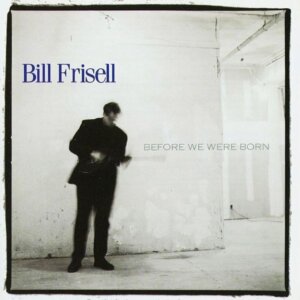
Is That You? (summer 1989), his second Elektra album, is even more complex in intention. Frisell retains only Baron from his core partners, assigns Wayne Horvitz a key role (including producer) as keyboardist and electronics programmer, and brings in Dave Hofstra (Microscopic Septet; frequent Zorn collaborator) on tuba and bass. This unusual instrumentation does not herald a new detour so much as support a problematic album – perhaps his most problematic and thus his most “no-genre.” Above all, Frisell appears to re-examine the relation between the music he makes and the music that inhabits his life, turning it in every light. He uses electric and acoustic guitars, banjo and ukulele in roughly equal measure, resurrects his long-dormant clarinet and embraces heavy overdubbing. Across twelve tracks he tries out endlessly varied chemical reactions between memory and inquiry, intent on strengthening his “artistic will” to make music by reflecting on what he has loved and internalised. The problem is that this will is anti-ego and his lack of assertiveness natural. There is no resort to linguistic exercise, Cagean collage or Zornian zap. Apart from the staging of emotional leaps, there are no sharp contrasts of situation – only variations of a single dominant emotional state. Across the album that state feels like pervasive bewilderment – a metabolised awareness of one’s own and others’ disorientation, poised between melancholy and neurosis. That psychic underpinning takes different shapes from track to track and within tracks, often through the intrusion of electric (or synthetic, via Horvitz) sounds into an acoustic or electro-acoustic frame. Emotion and form are not in a linear relation. In “No Man’s Land” and “Hello Nellie”, both dark acoustic melodies, a neurotic variant enters via mid-track electric-guitar episodes. In “Is That You?” a brief, strident electric flare drags a dreamy, major-key acoustic-symphonic melody toward an illusion of brightness.

Elsewhere, layers of the unsaid – emotions less transparent yet occupying busy frequencies – animate pieces without internal contrast, regardless of instrumentation. These are varied situations still. “Rag”, a solo acoustic-guitar miniature inspired by ragtime in its refrain, is upbeat and major-key yet converses, perhaps in spirit more than form, with a melancholic 3/4 “circus” bridge (à la “Little Brother Bobby”). “The Way Home”, with an all-electric/synthetic choral sonority, hides unease beneath major-key placidity. The same is true of “Days of Wine and Roses” (Mancini), where Frisell nebulises the delicate melody with electric haze over Baron’s measured pulse. Horvitz’s “Yuba City” marries a largely descending progression to Frisell’s raw electric over synthetic bed, overturning intimate unease with a cynical image of collective desolation. Three tracks seem to explain the album’s emotional substratum and frame its virtual concept. Halfway comes another miniature masterpiece, “Twenty Years”, a grainy, motionless banjo solo. The album closes with a two-part parable: “Half a Million”, electric-guitar duo with Baron, begins disturbed and melts into a blissful, major-key country melody; “Hope and Fear”, a short solo acoustic, sketches tender lyricism that soon darkens.

Between late 1990 and early 1991 Frisell recorded Where in the World? for Elektra with Roberts, Driscoll and Baron – an album of absolute value. Like Lookout for Hope, it achieves formal homogeneity without being a concept work, but in every other respect the parallel ends. Narrative is no longer sporadic: ten newly composed pieces suggest a mental or psychic voyage, a dream state that the music itself generates and resolves – a magical self-significance. Perhaps this could only follow Is That You?. The quartet’s sound has changed: more guitar/ukulele overdubbing; greater autonomy for Roberts’s cello; more chamber music – a new, combinatorial, sometimes impressionistic chamber music framed as a balanced container for electric sound and rock-descended rhythms. Performances are entirely score-governed; improvised parts are Frisell’s alone, a layer of subjective interpretation – theoretically informal, limited to sound character and slight melodic deviation. As on parts of Is That You?, Frisell favours a theme–variation–theme arc, often starting from thoughtful, melancholic, slow or pulse-less acoustic themes and loading the variations with electric intensity and marked rhythm. Variations reorder the original rhythmically or, more rarely, introduce a new theme, yet they never sever connection as in classical sonata.
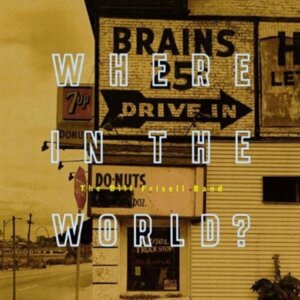
Few themes here are memorably melodic; they are themes of harmonic primacy – highly articulated and slow-moving or minimally repeating – evoking moods rather than places, dreamlike and surreal. The opener “Unsung Heroes” functions as a desolate prologue, as “Lookout for Hope” did on its album. “Rob Roy” and “Child at Heart” may also linger: perhaps the most imaginative tracks, felicitous fusions of Nino Rota-like harmonies and American melodicism. Little else begs to be singled out. “Smilin’ Jones”, folkloric and festive, fits like a light dissertation that neither contradicts nor encapsulates the whole. Where in the World? is a musical masterpiece that surpasses the formal self-significance of academic music and the procedural self-significance of pure improvisation.
Hank Roberts’s departure in 1991 coincided with the start of Frisell’s fruitful collaboration with clarinettist Don Byron. Byron invited him onto his ambitious debut Tuskegee Experiments (Elektra, late 1990–summer 1991). Soon after, they worked together on Hal Willner’s Mingus tribute Weird Nightmare: Meditations on Mingus (Columbia), with Frisell arranging several tracks. Their duo “Self-Portrait in Three Colors” adds a new gem to Mingus’s jewel – a piece of contemporary chamber music. The partnership deepened when Frisell formed a new group with Byron and accordionist Guy Klucevsek, plus Driscoll and Baron. Conceived expressly for a concept album turning his syncretic, dialectical vision of American music into a project, the result – recorded March 1992 for Elektra and titled Have a Little Faith (from John Hiatt’s “Have a Little Faith in Me”) – presents a personal anthology of American music spanning Copland’s Billy the Kid to Muddy Waters’s “I Can’t Be Satisfied”, Charles Ives’s “The ‘Saint-Gaudens’ in Boston Common” to Bob Dylan’s “Just Like a Woman”, John Philip Sousa’s “Washington Post March” to Madonna’s “Live to Tell”. Jazz is conspicuously scarce: a brief, lively take on Sonny Rollins’s “No More” that scarcely feels like jazz, and the evanescent, sophisticated standard “When I Fall in Love” (Victor Young for cinema).
Tellingly, Frisell grinds the seed of jazz as an arranger of classical scores. The seven Billy the Kid movements lift Copland out of the academy by combining Where in the World?’s score-versus-performance dialectic with sounds and cadences accessible to a broad listener – a contribution jazz alone brought to the global landscape. There is even a hint of free improv opening the mysterious “Prairie Night/Gun Battle.” By different means he also bathes two excerpts from Ives’s The ‘Saint-Gaudens’ in Boston Common in jazz: the first (c. 0:40 from the original start) becomes a colouristic interstice with lead voice alternating among electric guitar, accordion and clarinet; the second (c. three minutes from the end) gains a syncopated rhythm and concertante form with a knowingly jazzy clarinet solo.
These performances form the album’s core. Some other selections are more justifiable as parts of an arbitrarily principled concept than as formally compelling episodes: Sousa’s march works best as humorous insert, and “I Can’t Be Satisfied” takes on little new meaning. By contrast, the Dylan, Madonna and Hiatt songs – performed by Frisell’s trio without Byron and Klucevsek – are greatly enhanced as instrumentals.
The Have a Little Faith project is completed by its flip side, This Land (Elektra, October 1992), where Frisell the composer interprets the essence of American music by blending present and past creations. More organic as a whole, it is an apotheosis of Frisell as composer-arranger and as experimenter in emotionally accessible form. The group’s jazzier instrumentation – Byron (clarinet), Billy Drewes (alto), Curtis Fowlkes (trombone), with Driscoll and Baron – functions essentially as a warm chamber-music context for Frisell’s guitar, not a palette of jazz colours. Solos nod, at most, toward a jazz that bypasses bop, and always comment on music that does not speak of urban America. The cover, a Walker Evans photograph of a small Mississippi station (1936), signals as much. Even the blues is rarely “blues” – more a bluesy motif atop whatever structure, just as country, Caribbean and anthem-America references are subjected to the same subjective mediation. Each reference is an elsewhere seen from elsewhere; the cross-field logic governs individual tracks and the whole CD map alike. Suited to so-called emotional listening, its narrative structure is akin to a David Lynch film.
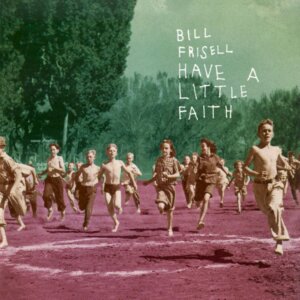
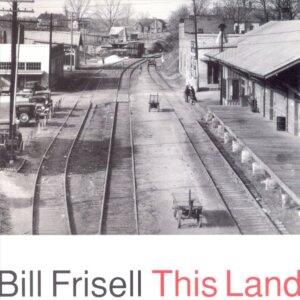
Only the opener, “Is It Sweet?”, a tiny country masterpiece, captivates by sheer joy; likewise the ensuing “Strange Meeting”, whose harmonic melody is enriched with tail modules one could hear forever. In “Jimmy Carter” (split across tracks three and four) a hymn is paraphrased via undulating melodies. Thereafter emotion passes through stronger filters; melody’s role dilutes into atmosphere. “This Land” is a uniform, static riff; “Dog Eat Dog” a Nino Rota/Kurt Weill-tinged meta-melody floating over predominantly sonic textures. After a watershed – the Caribbean-flavoured “Amarillo, Barbados” (supporting a performance anything but festive) and the bluesy “Monica Jane” (somewhat confused, bordering on list) – the asemic riffs “Resistor” and the 48-second “Unscientific Americans” alternate with Julius Hemphill’s amelodic narrative and the bumpy “Cartoon”. Hemphill’s feature is a long, tense meditation on atmospheres, drawing light from past-jazz fragments evoked in Fowlkes’s jungle trombone and Byron’s Ellingtonian clarinet. Unlike Have a Little Faith, This Land is a concept album in both content and form, designed for sequential listening, its visions of musical America arranged like a narrative interleaved with enumerative episodes. As on Is That You?, the epilogue is bipartite and clarifies the music–emotion relation: first a band-tinted re-imagining of “Rag”, then “Tag”, Baron’s short, slow, spartan, uniform, ritual drum solo fading into darkness. From here on, the “Americana” project forms the backdrop for much of Frisell’s future music – whether paying homage to a genre or transfigured into imaginative impressionism – primarily through original composition, with or without overt melody. Exceptions are the many sideman or co-led dates. Even Just So Happens (1994), a duo with Gary Peacock, feels like a missed opportunity in this sense: the bassist’s preference for free improv eclipses Frisell’s exquisite songs.
Around the time of the Peacock recording Frisell began writing for film. His scores for three Buster Keaton silents – conceived in the spirit of live accompaniments and previewed live in 1993 at St Ann’s in Brooklyn before studio recordings in 1995 – yielded two Elektra/Nonesuch releases, Go West and The High Sign/One Week. These are “prepared” improvisations, often very brief miniatures that capture the paradoxical, melancholy aspects of comic action. Organised by emotional logic from the outset, they showcase the expressive self-sufficiency of Frisell’s electro-acoustic sound – here supported only by Driscoll and Baron. Many Go West cues (e.g., “Me and the Cow”) exemplify atmosphere-building without melody overexposure; The High Sign/One Week, both “shorts”, display his gift for swift thematic transitions. Several themes reappeared – memorably – on the 1996 Nonesuch album Quartet, a concept-free programme that can be savoured track by track for the playing of a distinctive ensemble: Ron Miles (trumpet), Curtis Fowlkes (trombone), Eyvind Kang (violin) and tuba, with Frisell. The group spans warm to ambiguous tones with ease. The repertoire includes six cues from Gary Larson’s TV cartoon Tales from the Far Side (monstrous creatures), two from Daniele Luchetti’s La scuola (Italian everyday life), two from Keaton’s Convict 13, a reworking of “Twenty Years” (from Is That You?), and two improvised interludes. Differences among the sources matter less than mood. Frisell’s choice of musical references is creative and intuitive: the piercing waltz “Générique” for Far Side mixes New Orleans brass and blue notes with dark electric basses; an orthodox major blues winds up as classically comic commentary for Convict 13; La scuola’s “Coffaro’s Theme” hints at country and western; the captivating pop melody “Egg Radio” acquires concert-baroque splendour from brass and a country tint from steel guitar. Almost every piece testifies to Frisell’s imagination and the miraculous functioning of his ear. “Twenty Years”, arranged for this group, becomes a new masterpiece. Despite trumpet and trombone, overt jazz is scarce; jazz is not the named genre among the invoked.

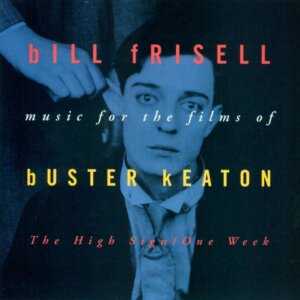

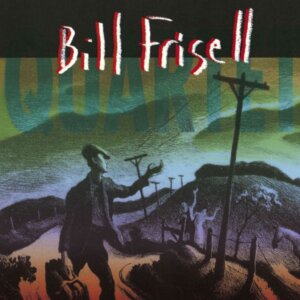
It makes little sense to compare Quartet to the contemporaneous concept album Nashville, Frisell’s tribute to country music, inspired by the genre and realised with a special poly-chordal group (two guitars, banjo, mandolin, double bass, with occasional harmonica and voice). Better to say they are two sides of Frisell’s art. Nashville delivers country “according to Frisell” (apart from Robin Holcomb’s covers) – ennobled by inevitable impressionistic subtleties. It isolates a single genre to explore its singular beauty: an elsewhere. Few tracks bristle with tension; fewer still absorb country’s rougher edges; instead they evoke the dreamy simplicity of contemplating nature. This does not signal any defection from Frisell’s larger dialectical horizon of Americanism as metaphor – that never happens – but inaugurates his tendency to favour the conceptual and emotional elaboration of simple forms. That tendency, one of his prerogatives, would become nearly exclusive for a time, and, under producer Lee Townsend, lead to a phase of mixed results.
For now, dialling down the linguistic filter between composition and the memory of “music once heard” yields four significant Nonesuch albums. The first, Gone, Just Like a Train (1997), recorded as a trio with Viktor Krauss (bass) and Jim Keltner (drums), is a vaguely themed concept album in which almost every piece stands out. Popular idioms mix and alternate within tracks; even when a single idiom prevails, the result feels like a tone-poem – a reverie, whether desolate or sweet. Harshness is rare – chiefly the opener, “Blues for Los Angeles”, a twelve-bar true-blue driven by rhythm and electricity. The new “Lookout for Hope”, once a harsher landscape, hardly disturbs the album’s intimacy, with its prevalent steel-guitar sonority reminiscent of acoustic timbre. Frisell aims to spotlight the poetic depth of country-ecstasy pieces – thoughtful yet not negative – by making that category protagonist and extending it to cognate situations that, though similar sonically, present less affirmative variants (“Godson Song”, “Egg Radio”, “Lonesome”, as well as “Nature’s Symphony” and “Sherlock”, which verge on tone poems; “Ballroom” evokes an empty floor more than dancing).
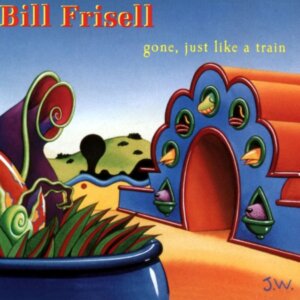
The principle of Gone, Just Like a Train reverberates in ensuing albums, none matching its Olympian economy of means. Good Dog, Happy Man (1998) centres again on country and kin, but the addition of Greg Leisz (second guitar), Ry Cooder (slide) and Horvitz (organ, piano, samples) nudges Frisell toward mainstream pop. Frisell remains the principal soloist, yet the arrangements somewhat dilute the music’s specific gravity – underlining the difference with the exquisite Gone, whose pieces mean themselves, beyond evocation. Few tracks here fully embody that quality (first among them the tender “Poem for Eva”). Still, Frisell’s storytelling and landscape-painting are unmistakable; the album is beautiful and beguiling. But “Americana” proves so specific that it resists pointing elsewhere – not unlike Nashville country as a distinct style.
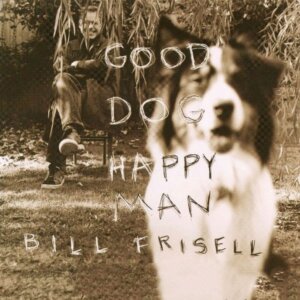
The true postscript to Gone is the solo Ghost Town (1999). Returning to introspective American music more deeply than ever, Frisell uses extensive overdubbing – sometimes adding electric bass to guitars and banjo – controlling the entire musical field himself. He had tried this technique only sparingly back on In Line, but within the Americana phase it makes a crucial, likely psychological, difference. Notably, only two of the country pieces are genre classics (A. P. Carter; Hank Williams), appearing like serene escapes amid a journey of emotions that persist even when the past emerges intact in form – shadows remain, even in sweetness. Varied in form, the album shades melancholy across pieces, letting evocative music move the listener without explicit narration. Americanism lies in Frisell’s sound, electric or acoustic. Melodies feel like private dreams: the sweetness of “Poem for Eva”, the anguish of “Tales from the Far Side” and “Winter Always Turns to Spring”, the banjo-reduced essence of “When I Fall in Love”.

On Ghost Town he experiences the Americana project under a maximal psychic filter. On Blues Dream (2001) he manages it with creative authorial discretion. The title does not strictly name the content: “blues” alludes to the common ground of American popular musics – black and white, urban and rural – and, here, to elements of jazz. The ensemble adds three winds (Fowlkes, Ron Miles, Billy Drewes) to a quartet of guitars (Frisell; Greg Leisz on guitar/mandolin), bass (David Piltch) and drums (Kenny Wollesen). More than ever, idioms blend within pieces; each combines at least one sound and one melody from different traditions, often more: blues, jazz, country (including bluegrass), jazz-rock, soul, gospel, spirituals, Hawaiian, 20th-century chamber music and chamber jazz. Tellingly absent are pop and rock as such – already derivative combinatorial idioms. “Pop” functions at most as the virtual glue, keeping balance à la Frisell whether the surface reads “sad” or “happy.” Emotional tones are not mixed into a single unit; they are camouflaged behind that surface, as Frisell inevitably does. Blues Dream closes the second phase of correspondence between Americana and the concept (or quasi-concept) album, as well as Frisell’s first two decades as leader. His continuous poetic evolution remains protagonist. From 2001 into the mid-2000s, his output hovers between a somewhat faded re-hearing of earlier work and somewhat gratuitous digressions.
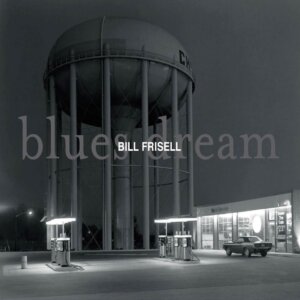
Nothing is banal or poorly made, yet little feels strictly “necessary.” This applies to the two jazz albums with Dave Holland and Elvin Jones (2001) and with Ron Carter and Paul Motian (2005) – both containing splendid playing; to East/West and Further East/Further West, a pair of live albums (one “pop” from Los Angeles, one “jazz” from New York); and to three concept albums of the period, each crafted with care.
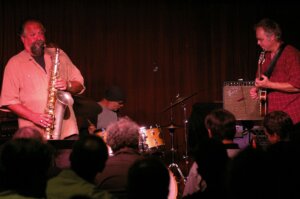
With The Willies (2002) Frisell returns to a blend of American folk, joined by banjoist Danny Barnes and bassist Keith Lowe, with a repertoire dominated by traditionals. The Intercontinentals (2003) widens the lens: Malian percussion (Sidiki Camara), Brazilian guitar (Vinícius Cantuária – later Lágrimas Mexicanas, Naïve, 2011) and Greek oud (Christos Govetas) inform Frisell’s instrument, writing and arranging. Unspeakable (2004), produced by Hal Willner, presents Frisell as nominal leader of a polymorphous rock-leaning band with a highly “produced” sound – twelve musicians including Willner on turntables and samples. Frisell’s authorship is unmistakable in very few tracks; the short “Hymn for Ginsberg” is perhaps the most.
The period’s most demanding project is the Richter 858 suite (2002), a musical commentary on Gerhard Richter’s cycle 858 (San Francisco MoMA), released on CD by Songlines in 2005. An eminently chamber-music work, it is the first time Frisell places his ars combinatoria in exclusive reaction with the European avant-garde, choosing collaborators accordingly: a string trio – Jenny Scheinman (violin), Eyvind Kang (viola), Hank Roberts (cello) – to contextualise guitar timbres. Across eight movements corresponding to the paintings, Frisell shifts deftly among syntaxes and atmospheres. His compositional signature remains audible in more intelligible stretches, regardless of the harmonic field, and in repetitive, often rhythmic passages; even in abstract episodes recalling Ligeti he leaves minimal clues. One might ask about the necessity of this reformulation beyond demonstrating yet another possibility of his poetics. Probably not much – perhaps not even to Frisell. Two facts suggest as much. First, he subsequently used strings chiefly to create the impressionistic, American, no-genre music that has always distinguished him. Second, his next leader project came only in 2008 – an anthology of portraits of his attitudes and passions, as if picking himself up after a period of yielding to circumstance or creative stall (however imperceptible).
That challenging work, the Nonesuch double CD History, Mystery, is a suite of thirty pieces from various dates, studio and live, arranged with intimate logic. All the genres that nourish Frisell’s eclectic nature alternate and intersect, benefiting from an ensemble that juxtaposes his basic trio (by now Tony Scherr and Kenny Wollesen) with two winds (Ron Miles, cornet; Greg Tardy, tenor/clarinet) and the Richter 858 strings (Scheinman, Kang, Roberts). What is missing is any iconoclastic urge: the music is wholly natural and fluid, piece to piece and as a whole – the frankness of a rigorous account of the present, perhaps more ideal than factual. It feels heartfelt and alive. “Monroe” and “Baba Drame” (Boubacar Traoré), carried over from Good Dog, Happy Man and The Intercontinentals, are given new meaning; Sam Cooke’s “A Change Is Gonna Come”, Monk’s “Jackie-ing” and Konitz’s “Subconscious-Lee” are beloved pieces Frisell “missed” earlier. Predominant among the new originals are syntheses he might have created in the past but now realises with a sedimented consciousness. None is long; some recur in multiple versions (e.g., “Monroe”); a handful of brief interludes refresh the suite. History, Mystery is the “great work” that leaves its imprint on subsequent production – music with softened edges at times, touched by a somewhat escapist phase, yet punctuated by clear images of wise, conscious maturity.
The lineage of History, Mystery is visible in chamber-leaning projects of differing aim and form. Disfarmer (Nonesuch, 2009) – a musical commentary on the social photographer Mike Disfarmer – is a sequence of Americana sketches for Frisell and Greg Leisz (guitars) with Scheinman’s violin. Two 858 Quartet albums diverge from one another and from the initial string work: Sign of Life (Savoy, 2010) is devoted to Frisell’s most delicate, reflective chamber writing; Big Sur (OKeh, 2013) – born of a Glen Deven Ranch residency and premiered at Monterey – veers toward a more descriptive register and adds Rudy Royston on drums. More direct descendants in intent than in form are Beautiful Dreamers (Savoy, 2010) – a trio with Kang (viola) and Royston shaping an elegant tripolar sound across sixteen miniatures that move from light to reflective, from popular to cultivated, from simple to intricate – and the enchanting Music IS (OKeh, 2017), a self-aware solo stage with a slight preponderance of older pieces over new. “One of the surprising things about getting old,” Frisell said then, “is being able to revisit things I listened to or played a long time ago. There is always something new to discover, something to bring out again.”

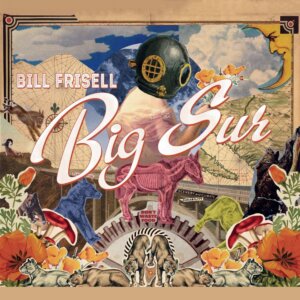
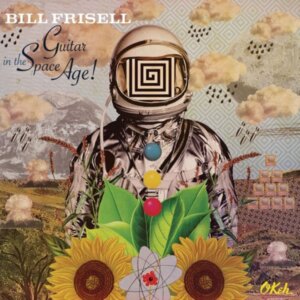
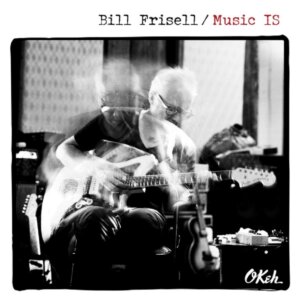
Similar intentions inflect much of his recent leader output, no matter how diverse – from the Zorn-produced Silent Comedy (2012), a set of sound improvisations honouring their old friendship, to concept albums devoted to John Lennon (All We Are Saying, 2011), 1960s pop (Guitar in the Space Age!, 2014), and songs from films and series (When You Wish Upon a Star, 2015), and to original-plus-covers projects suited to singing (Harmony, 2019). These are sincere passions; it is hard to imagine any excluded from his auteur policy.
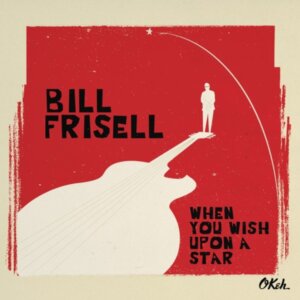

Context matters, though. If we assess the value of form generating emotion through original richness in each work, then, absent factors that justify every formal choice in relation to authorship, the post-History, Mystery production cannot be classed at the same level nor as a sequence of masterpieces. In pure sound improvisation Frisell’s elsewhere-language is practically absent – the circumstances do not require it. In pop-song projects, programmatic adherence to referents tends to impoverish precious dynamics, yielding something like an authorial metalanguage (with the possible exception of certain originals on Harmony). Without quicksilver references that border on dream, Frisell’s elsewhere-language has limited scope. His decision to concentrate on a single passion is unilateral and carries consequences – as the happy yet limiting exclusivity of Nashville’s country focus once showed.
In recent years Frisell’s elsewhere forms have also grafted onto jazz as commonly understood – a genre he has mostly practised as sideman and never chosen as the imaginative locus. The memorable “Some Song and Dance” (1988) welcomed those forms in a mediated sense; later jazz inspired him to interpret classics (not only Monk) with evident passion and to compose originals that move beyond mere emotional entertainment. Reflection took time – perhaps because Frisell himself needed time to process it, given his autonomy. In March 2016 at the Village Vanguard, with bassist Thomas Morgan, he played jazz (Monk, Strayhorn, Konitz, Motian), Americana, pop and Frisell originals in an intimate, reflective, nuanced setting. ECM released Small Town and Epistrophy.
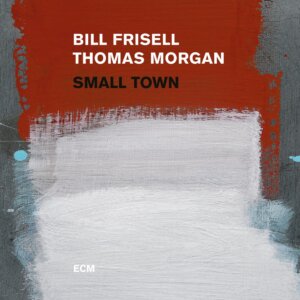
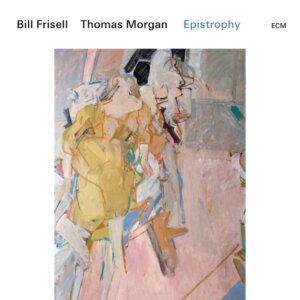
Valentine (Blue Note, 2019), a trio with Morgan and Royston, presents more articulated jazz. The title track – a blues paraphrase of “Epistrophy” – is Frisell’s most jazz-centred piece to date, yet it sits slightly apart from the album’s overall climate. “A Flower Is a Lovesome Thing” (Strayhorn) is as delicate as its theme, recalling the subdued tone of the Vanguard discs. Elsewhere the performances all express Frisellian motifs – originals or not – enriched by the jazz-inflected presence of Morgan’s bass and especially Royston’s drums.

The very recent Four (Blue Note) shows the balance fully – a remarkable album. The quartet – Greg Tardy (tenor sax, clarinet, bass clarinet), Gerald Clayton (piano), Johnathan Blake (drums) – was conceived to preserve each musician’s individuality even when the music, by Frisell’s history, might tend toward the symphonic. The programme consists solely of originals, all drawing on deeply Frisellian motifs, and resonates with History, Mystery. Without concept-album scaffolding, a retrospective corrective seems to bind four pre-existing titles to nine new pieces in spirit and form: moving dedications to recently departed friends (including producer Hal Willner), chapters with varying doses of Americana and impressionism, side-glances that draw surreal, perhaps Monk-tinged irony, and introspective dreamscapes along an autobiographical trajectory. One piece, entrusted wholly to Clayton’s piano, is “new” only physically. Materials from the real past need new life: sublime themes born in somewhat superficial frames – “Good Dog, Happy Man”; the ever-magnetic “Lookout for Hope”, revived in the warm gloom of acoustic timbres dominated by Tardy’s bass clarinet and Clayton’s piano. Even here, jazz is not equated with the other idioms interacting in Frisell’s elsewhere; the “Monk space” remains somewhat distinct. Jazz is fully exploited where it is precious regardless of language, and in that sense recognised as more precious than ever – associated here with the honest need to make an emotional album in a post-lockdown world. Four thus resonates from piece to piece.

